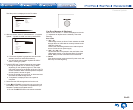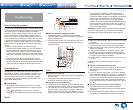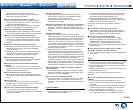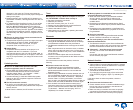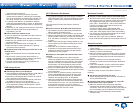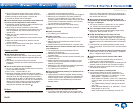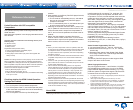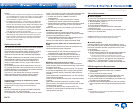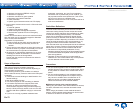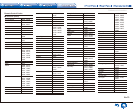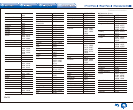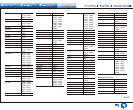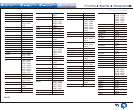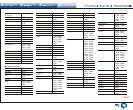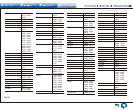
Reference Information
En-71
● Sound files that are protected by copyright cannot be played.
● When the USB audio player and this unit are connected, the
audio player screen and the screen of the unit may be different.
In addition, control functions of the audio player (classifying and
sorting music files and adding information, etc.) are not available
on this unit.
● Do not connect a PC to the USB port of the unit. Inputting sound
to the USB port of the unit from a PC is not possible.
● Media inserted to the USB card reader may not be available in
this function.
● Some USB storage devices and its contents may require some
time to be read.
● Depending on the USB storage device, proper reading of the
contents and proper supply of the power supply may not be
possible.
● Onkyo accepts no responsibility whatsoever for the loss or
damage to data stored on a USB storage device when that
device is used with this unit. We recommend that you back up
your important music files beforehand.
● Performance of the hard disk that receive power from the USB
port of the unit is not guaranteed.
● If you connect a USB hard disk drive to the USB port of the unit,
we recommend that you use its AC adapter to power it.
● When an audio player that are operated with batteries is used,
make sure that the batteries have enough remaining power.
● This unit does not support USB storage devices with security
functions.
Supported Audio Formats
● For server playback and playback from a USB storage
device, this unit supports the following music file
formats.
● Music files of the following formats that can be played
depend on the network server. For example, when using
Windows Media
R
Player 12, not all music files in the PC
can be played. The music files that can be played are
the ones registered to the Windows Media
R
Player 12
library.
● Variable bit-rate (VBR) files are supported. However,
playback times may not be displayed correctly.
● This unit supports the gapless playback of the USB
storage device in the following conditions.
When WAV, FLAC and Apple Lossless files are
continuously played back with the same format,
sampling frequency, channels and quantization bit rate
● Remote playback does not support the gapless
playback.
● For playback via wireless LAN, the sampling rate of
88.2 kHz or higher, DSD and Dolby TrueHD are not
supported.
Caution:
● With remote playback on this unit the following formats are not
supported:
− FLAC, Ogg Vorbis, DSD and Dolby TrueHD.
¼ MP3 (�mp3 or �MP3)
● Supported formats: MPEG-1/MPEG-2 Audio Layer 3
● Supported sampling rates: 8 kHz, 11.025 kHz, 12 kHz,
16 kHz, 22.05 kHz, 24 kHz, 32 kHz, 44.1 kHz, 48 kHz
● Supported bitrates: Between 8 kbps and 320 kbps.
Incompatible files cannot be played.
¼ WMA (�wma or �WMA)
WMA stands for Windows Media Audio and is an audio
compression technology developed by Microsoft
Corporation� Audio can be encoded in WMA format by
using Windows Media® Player�
● Supported sampling rates: 8 kHz, 11.025 kHz, 16 kHz,
22.05 kHz, 32 kHz, 44.1 kHz, 48 kHz
● Supported bitrates: Between 5 kbps and 320 kbps.
Incompatible files cannot be played.
● WMA Pro/Voice formats are not supported.
¼ WMA Lossless (�wma or �WMA)
● Supported sampling rates: 44.1 kHz, 48 kHz, 88.2 kHz,
96 kHz
● Quantization bit: 16 bit, 24 bit
¼ WAV (�wav or �WAV)
WAV files contain uncompressed PCM digital audio.
● Supported sampling rates: 8 kHz, 11.025 kHz, 12 kHz,
16 kHz, 22.05 kHz, 24 kHz, 32 kHz, 44.1 kHz, 48 kHz,
64 kHz, 88.2 kHz, 96 kHz, 176.4 kHz, 192 kHz
● Quantization bit: 8 bit, 16 bit, 24 bit
¼½ For playback from a USB storage device, sampling rates of 176.4 kHz
and 192 kHz are not supported.
¼½ For playback from a USB storage device, 5.1 ch is not supported.
¼ AAC
(�aac/�m4a/�mp4/�3gp/�3g2/�AAC/�M4A/�MP4/�3GP or
�3G2)
● Supported formats: MPEG-2/MPEG-4 Audio
● Supported sampling rates: 8 kHz, 11.025 kHz, 12 kHz,
16 kHz, 22.05 kHz, 24 kHz, 32 kHz, 44.1 kHz, 48 kHz,
64 kHz, 88.2 kHz, 96 kHz
● Supported bitrates: Between 8 kbps and 320 kbps.
Incompatible files cannot be played.
¼ FLAC (�flac or �FLAC)
FLAC is a file format for lossless audio data
compression�
● Supported sampling rates: 8 kHz, 11.025 kHz, 12 kHz,
16 kHz, 22.05 kHz, 24 kHz, 32 kHz, 44.1 kHz, 48 kHz,
64 kHz, 88.2 kHz, 96 kHz, 176.4 kHz, 192 kHz
● Quantization bit: 8 bit, 16 bit, 24 bit
¼½ For playback from a USB storage device, sampling rates of 176.4 kHz
and 192 kHz are not supported.
¼½ For playback from a USB storage device, 5.1 ch is not supported.
¼ Ogg Vorbis (�ogg or �OGG)
● Supported sampling rates: 8 kHz, 11.025 kHz, 16 kHz,
22.05 kHz, 32 kHz, 44.1 kHz, 48 kHz
● Supported bitrates: Between 32 kbps and 500 kbps.
Incompatible files cannot be played.
● Incompatible files cannot be played.
¼ LPCM (Linear PCM)
● Supported sampling rates: 44.1 kHz, 48 kHz
● Quantization bit: 16 bit
¼½ Only for playback via DLNA.
¼ Apple Lossless (�m4a/�mp4/�M4A/�MP4)
● Supported sampling rates: 8 kHz, 11.025 kHz, 12 kHz,
16 kHz, 22.05 kHz, 24 kHz, 32 kHz, 44.1 kHz, 48 kHz,
64 kHz, 88.2 kHz, 96 kHz
● Quantization bit: 16 bit, 24 bit
¼ DSD (�dsf or �DSF)
● Supported sampling rates: 2.8224 MHz, 5.6448 MHz
¼½ For playback from a USB storage device, 5.6448 MHz is not supported.
¼ Dolby TrueHD (�vr/�mlp/�VR/�MLP)
● Supported sampling rates: 48 kHz, 64 kHz, 88.2 kHz,
96 kHz, 176.4 kHz, 192 kHz
¼½ Only sampling rates of 48 kHz is supported for playback from USB.
¼½ Playback via DLNA is not supported.
¼½ For playback from a USB storage device, 7.1 ch is not supported.
Radio Wave Caution
The AV receiver uses a 2.4 GHz radio wave
frequency, which is a band used by other wireless
systems as 1 and 2 described below.
1. Devices which use a 2.4 GHz radio wave frequency
● Cordless phones
● Cordless facsimiles
● Microwave ovens



